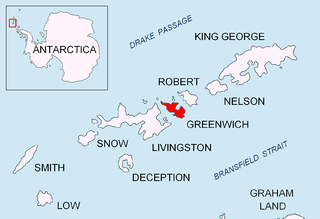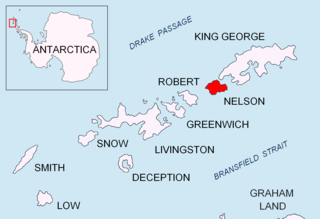
Danco Island or Isla Dedo is an island off Antarctica, 2 kilometres (1 nmi) long lying in the southern part of Errera Channel, off the west coast of Graham Land. It was charted by the Belgian Antarctic Expedition under Adrien de Gerlache, 1897–1899. Danco Island was surveyed by the Falkland Islands Dependencies Survey from Norsel in 1955, and named by the UK Antarctic Place-names Committee for Emile Danco (1869–1898), a Belgian geophysicist and member of the Belgian Antarctic Expedition, who died on board Belgica in the Antarctic.

The Dailey Islands are a group of small volcanic islands lying off the coast of Victoria Land, 9 kilometres (5 nmi) northeast of Cape Chocolate, in the northern part of the ice shelf bordering McMurdo Sound. They were discovered by the British National Antarctic Expedition, 1901–04, under Robert Falcon Scott, and named for Fred E. Dailey, the expedition carpenter.

The Windmill Islands are an Antarctic group of rocky islands and rocks about 11.1 kilometres (6 nmi) wide, paralleling the coast of Wilkes Land for 31.5 kilometres (17 nmi) immediately north of Vanderford Glacier along the east side of Vincennes Bay. Kirkby Shoal is a small shoal area with depths of less than 18 metres (59 ft) extending about 140 metres (459 ft) westwards and SSW, about 3.4 kilometres (2.1 mi) from the summit of Shirley Island, Windmill Islands, and 0.24 kilometres (0.15 mi) NW of Stonehocker Point, Clark Peninsula.

The Ibar Rocks are two rocks located 0.4 kilometres (0.2 nmi) east of Bonert Rock and 1 kilometre (0.6 nmi) southeast of Canto Point, Greenwich Island, in the South Shetland Islands. The names "Islote Ibar" and "Islote Teniente Ibar" appearing on Chilean hydrographic charts in the 1950s refer to the larger and western rock. The recommended name "Ibar Rocks" includes a submerged outlier to the northeast of the larger rock. Teniente (lieutenant) Mario Ibar P. signed the official act of inauguration of the Chilean Captain Arturo Prat Base on Greenwich Island in 1947.

Anton Island is a low ice-capped island about 1 kilometre (0.5 nmi) long. It lies 9 kilometres (5 nmi) north-northeast of Lewis Island, just outside the east side of the entrance to Davis Bay. It was discovered in 1956 from the MV Kista Dan by an Australian National Antarctic Research Expedition led by Phillip Law that landed on the island on 18 January 1960, and was named by the Antarctic Names Committee of Australia for Anton Moyell, first officer on the MV Magga Dan in 1960.

Benton Island is an ice-covered island about 7 kilometres (4 nmi) long, lying 9 kilometres (5 nmi) northwest of Nolan Island in the Marshall Archipelago. It was mapped by the United States Geological Survey from surveys and from U.S. Navy air photos, 1959–65, and named by the Advisory Committee on Antarctic Names for William T. Benton, BM1, U.S. Navy, Boatswain's Mate aboard USS Glacier along this coast, 1961–62.

Bertha Island is an island 4.6 kilometres (2.5 nmi) long, lying 1.9 kilometres (1 nmi) south of Islay at the east side of William Scoresby Bay. It was discovered and named in February 1936 by Discovery Investigations personnel on the William Scoresby.

Borceguí Island is an ice-free island in the South Shetland Islands, midway between Cape Yelcho and the Gibbous Rocks, 2 kilometres (1 nmi) off the north coast of Elephant Island. The name was applied by the command of the Argentine sea-going tug Chiriguano in the 1954–55 cruise; in Spanish "borceguí" means half-boot and describes the shape of the island.

Broka Island is a rocky island, 7.4 kilometres (4 nmi) long and rising to 140 metres (460 ft), with a prominent cove indenting the north side, situated 3.7 kilometres (2 nmi) north of Law Promontory and 1.9 kilometres (1 nmi) west of Havstein Island. It was mapped by Norwegian cartographers from aerial photographs taken by the Lars Christensen Expedition, 1936–37. They applied the name Broka because the outline of the island resembles that of a pair of trousers.

The Canopus Rocks are two small, low rocks lying 2 kilometres (1 nmi) northwest of Canopus Island, 2 kilometres (1 nmi) east of Nella Rock and the Sawert Rocks, and 1.9 kilometres (1 nmi) southeast of Hansen Rocks in the eastern part of Holme Bay, Mac. Robertson Land. They were plotted from photos taken from Australian National Antarctic Research Expeditions aircraft in 1958, and named by the Antarctic Names Committee of Australia after Canopus Island.

Couling Island is an island 1.9 kilometres (1 nmi) long, lying 2 kilometres (1 nmi) north of Islay in the William Scoresby Archipelago. It was discovered and named by Discovery Investigations personnel on the William Scoresby in February 1936.

Johnson Island is an ice-covered island, about 17 kilometres (9 nmi) long and 9 kilometres (5 nmi) wide, lying within the Abbot Ice Shelf, Antarctica, about 26 kilometres (14 nmi) southeast of Dustin Island. The feature was observed and roughly positioned as an "ice rise" by parties from the USS Glacier (AGB-4) in February 1961. It was remapped by the United States Geological Survey from U.S. Navy air photos, 1966, and was named by the Advisory Committee on Antarctic Names for Theodore L. Johnson, an electrical engineer at Byrd Station in 1964–65.

Descartes Island is a rocky island 0.2 kilometres (0.1 nmi) long, midway between Lagrange Island and La Conchee and 1.7 kilometres (0.9 nmi) north-northeast of Cape Mousse. It was charted in 1951 by the French Antarctic Expedition and named after René Descartes, the French mathematician and philosopher.

Grinder Island is one of the ice-covered islands in the Marshall Archipelago, located within the Sulzberger Ice Shelf off the coast of Marie Byrd Land, Antarctica. The island is 13 kilometres (7 nmi) long and 2 kilometres (1 nmi) wide and lies 24 kilometres (13 nmi) southwest of Steventon Island. It was mapped by the United States Geological Survey from surveys and U.S. Navy air photos, 1959–65, and was named by the Advisory Committee on Antarctic Names for Harry W. Grinder, a U.S. Navy aviation structural mechanic of McMurdo Station, 1967.

Grace Rock is a rock in Bransfield Strait, Antarctica lying 1.72 kilometres (0.93 nmi) off the southeast coast of Nelson Island in the South Shetland Islands. It was named by the UK Antarctic Place-Names Committee in 1961 after the British sealing vessel Grace from Plymouth, which visited the South Shetland Islands in 1821–22.

Francis Island is an island which is irregular in shape, 13 kilometres (7 nmi) long and 9 kilometres (5 nmi) wide, lying 22 kilometres (12 nmi) east-northeast of Choyce Point, off the east coast of Graham Land, Antarctica. It was discovered and photographed from the air by the United States Antarctic Service in 1940. It was charted in 1947 by the Falkland Islands Dependencies Survey (FIDS), who named it for S.J. Francis, a FIDS surveyor.

Kitney Island is a small island 2 kilometres (1 nmi) east-northeast of the Smith Rocks, 2 kilometres (1 nmi) southwest of the Wiltshire Rocks, and 5 kilometres (2.5 nmi) northwest of the Paterson Islands, off the coast of Mac. Robertson Land, Antarctica. The Lars Christensen Expedition (1936) first mapped this island which, though left unnamed, was included in a small group named by them "Spjotoyskjera". It was remapped by the Australian National Antarctic Research Expedition (ANARE) in 1956, and was named by the Antarctic Names Committee of Australia for V.J. Kitney, a supervising technician (radio) at Mawson Station in 1968.

Thode Island is a small ice-covered island situated in the Sulzberger Ice Shelf, located 1.9 kilometres (1 nmi) northwest of Benton Island and 9.3 kilometres (5 nmi) east of Przybyszewski Island in the Marshall Archipelago. The island was first mapped by the United States Geological Survey from surveys and U.S. Navy air photos, 1959-65. Named by Advisory Committee on Antarctic Names for George C. Thode, electronic technician and meteorologist at Byrd Station in 1968.

Larrouy Island is an island 9 kilometres (5 nmi) long and 4 kilometres (2 nmi) wide which rises to 745 metres (2,440 ft), lying in Grandidier Channel off the northwest coast of Velingrad Peninsula 7 kilometres (4 nmi) north of Ferin Head, Antarctica. It was discovered by the French Antarctic Expedition, 1903–05, under Jean-Baptiste Charcot, who named it for Paul Augustin Jean Larrouy, at that time a French Minister Plenipotentiary.

Newton Island is a rocky island 0.9 kilometres (0.5 nmi) northwest of Laplace Island and 2 kilometres (1.2 nmi) north-northwest of Cape Mousse, Adélie Coast, Antarctica. It was charted in 1951 by the French Antarctic Expedition and named after Sir Isaac Newton, English philosopher and mathematician.










